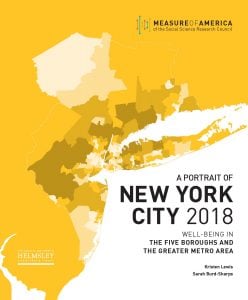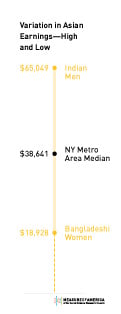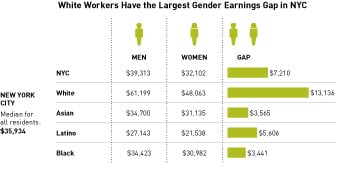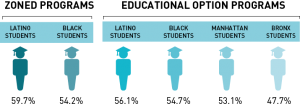North Brooklyn Cops and Kids Bond Over NYPD’s Flag Football Initiative
October 5, 2018 — The Bushwick Daily
Race, Gender & Salaries in NYC
June 18, 2018 — The Brian Lehrer Show – WNYC
A Portrait of New York City 2018
LAUNCHED JUNE 21, 2018 | FULL REPORT | MEDIA RELEASE | FIVE NEW YORKS PHOTO ESSAY
INTERACT WITH THE DATA: Well-Being in NYC Map | Five New Yorks Map
Click here to view the interactive webinar, Harnessing the Power of Data, on August 9th, 2018.
RELATED PROJECTS: See the “mini-portraits” made by service-delivery organizations for the Community Portraits Project and explore 300+ well-being indicators on DATA2GO.NYC.
 A Portrait of New York City 2018: Well-Being in the Five Boroughs and the Greater Metro Area examines well-being and access to opportunity for different geographies and demographic groups in New York City and the greater New York–New Jersey–Connecticut metropolitan area using the human development framework and index. This report also examines a range of issues that contribute to and/or are compounded by the well-being challenges faced by many New York City communities, such as child poverty, health inequities, racism, and residential segregation.
A Portrait of New York City 2018: Well-Being in the Five Boroughs and the Greater Metro Area examines well-being and access to opportunity for different geographies and demographic groups in New York City and the greater New York–New Jersey–Connecticut metropolitan area using the human development framework and index. This report also examines a range of issues that contribute to and/or are compounded by the well-being challenges faced by many New York City communities, such as child poverty, health inequities, racism, and residential segregation.
The American Human Development Index, a supplement to the gross domestic product and other money metrics, tells the story of how ordinary people are doing. The index is based on the Human Development Index developed by the United Nations, the gold standard for measuring the well-being of people in every nation.
This report presents the ranked index for 170 neighborhood and town clusters in the New York metro area; for the five boroughs and for 188 neighborhood tabulation areas in New York City; for the four major racial and ethnic groups; for women and men; and for US- and foreign-born residents.
KEY FINDINGS
AMERICAN HUMAN DEVELOPMENT INDEX: NEW YORK METRO AREA
- The American Human Development Index score for the greater New York metro area (6.32) is higher than the score for the city proper (5.98) and the United States as a whole (5.17).
- Despite a longer life expectancy and higher education levels, women scor
 e slightly lower than men on the index (6.25 vs. 6.30) due to a $12,500 gender earnings gap.
e slightly lower than men on the index (6.25 vs. 6.30) due to a $12,500 gender earnings gap. - Of the four major racial and ethnic groups studied in this report, Asian metro area residents score highest on the HD Index, followed by white, black, and Latino residents. The Asian and white scores are similar (7.54 and 7.16, respectively), as are the black and Latino scores (4.87 and 4.83).
- The top-scoring neighborhood and town cluster of the 170 analyzed in the metro area is the Upper East Side in New York City (9.36). This area also scores highest in terms of education. The highest earnings are also found in Manhattan, in Battery Park City, Greenwich Village, and Soho. Southeast Westchester County fares best in terms of life expectancy.
- Southwest Newark, New Jersey has the lowest HD Index score and the lowest average life expectancy. The Hunts Point, Longwood, and Melrose section of the Bronx has the lowest education score, and Belmont, Crotona Park East, and East Tremont, also in the Bronx, has the lowest earnings.
AMERICAN HUMAN DEVELOPMENT INDEX: NEW YORK CITY
- New York City scores 5.98 out of 10 on the American Human Development Index, higher than the United States but lower than the New York metro area. The city also has higher highs and lower lows than the greater metro area.
- On average, Asian and white New Yorkers enjoy relatively high levels of well-being, while black and Latino New Yorkers have HD Index scores below the city average. White residents have the highest score (7.63) and Latino residents have the lowest (4.58).
- Women score higher than men on the HD Index (6.16 vs. 5.87) due to higher average life expectancies and education levels.
- Carnegie Hill on the Upper East Side has the highest score (9.34) of all 188 NYC neighborhood tabulation areas. Of the ten highest-scoring neighborhoods, nine are in Manhattan and one is in Brooklyn. All ten lowest-scoring neighborhoods are in the Bronx. Claremont-Bathgate scores the lowest (2.71).
- HD Index scores can be used to track improvements over time, but in a city where neighborhoods are rapidly transforming, it can be difficult to determine if rising well-being levels are due to better outcomes for existing residents or to changes in population demographics. According to an analysis of the racial compositions of the fifty-nine NYC community districts since 2000, the black share of the population has decreased by more than 5 percentage points in fourteen neighborhoods. At the same time, many traditionally black and Latino neighborhoods experienced an influx of white residents.
- A child born today in New York City can expect to live for 82.3 years. If New York City were a country, it would rank eighth in life expectancy, tied with Sweden.
- Foreign-born New Yorkers can expect to live six years longer, on average, than those born in the United States. This life expectancy advantage tends to fade the longer immigrants live in the United States.
- There is a five-year life expectancy gap between NYC men (80.2 years) and women (85.3 years).
- More than a decade separates the life expectancy of the city’s Asian residents (89.3 years) and its black residents (79.2 years). Latinos and whites fall between the two; Latinos are the second-longest-lived group (83.5 years), and whites are the third (82.6 years).
- There is a thirteen-year difference in life expectancy between the longest- and shortest-lived NYC community district; residents of Bayside, Douglaston, and Little Neck in Queens have a life expectancy of 89.6 years, compared to a 76.7-year life expectancy for residents of Brownsville and Ocean Hill in Brooklyn.
- Heart disease and cancer are the two leading causes of death across all four racial and ethnic groups, but black New Yorkers are more likely to die from preventable causes such as infant death in the first twenty-eight days, HIV, and homicide.
Access to Education
- New York City scores 5.45 on the Education Index. Although New York scores higher on the Education Index than the United States as a whole (5.45 compared to 5.17) due to higher levels of bachelor’s and graduate degree attainment, almost one in five adults in the city lacks a high school diploma.
- On average, women in New York City have higher educational attainment levels than men, with an Education Index score of 5.52, compared to 5.37.
- Education Index scores of US- and foreign-born New Yorkers are separated by nearly three points—6.44 compared to 3.54. Foreign-born New Yorkers are less likely to be enrolled in school and less likely to have attained a high school, bachelor’s, or graduate degree. Educational attainment and enrollment rates for immigrant New Yorkers vary considerably by race and ethnicity, however.
- White residents score the highest on the Education Index (7.67). Asians score second highest (5.76), but educational outcomes vary considerably by Asian subgroup. Black New Yorkers come in third (4.54) and Latino New Yorkers have the lowest score (3.24), though, again, educational attainment varies by subgroup.
- Education Index scores vary tremendously across New York City neighborhoods, ranging from Carnegie Hill on the Upper East Side, with a score of 9.50, to North Corona in Queens, which scores just 1.38.
- Low Education Index scores are associated with higher rates of poverty, child poverty, unemployment, incarceration, and births to teenagers. Higher education scores are associated with higher median personal earnings.
A Decent Standard of Living
- NYC median personal earnings are $35,934, above the US median of $31,416.
- The typical white worker takes home $52,290, over $20,000 more than the typical Asian or black worker (with median earnings of $32,156 and $32,059, respectively) and twice the earnings of the typical Latino worker ($25,086).
- Men earn $7,000 more than women in NYC, despite women’s superior performance on the Education Index. The gender earnings gap is widest for white workers—white men typically earn $13,100 more than white women in the city. Black men and women have the smallest gender earnings gap, likely a sign of disproportionate discrimination faced by black men rather than an advantage for black women.
- US-born New Yorkers make $11,000 more than foreign-born New Yorkers. NYC Asians have the largest gap: Asians born in the United States earn over $18,000 more than those who immigrated.
- Earnings range from a median of $95,000 in Carnegie Hill on the Upper East Side to $14,400 in the Bronx neighborhood of Belmont.
- Over 50 percent of New Yorkers qualify as rent burdened (spending more than 30 percent of their incomes on rent and utilities), the third-highest rate of the ten most populous US metro areas.
- There is a strong negative relationship between incarceration rates and earnings in New York City neighborhoods.
CONCLUSION
The report concludes with an ambitious but realistic goal: to increase well-being for all city residents and narrow the gaps between groups, resulting in an increase in the HD Index— from today’s 5.98 to 6.60 by 2025.
To achieve this goal in a way that results in measurable well-being improvements for all, with a focus on the most vulnerable residents, the following areas are priorities:
HEALTH: Structuring neighborhood, school, and work environments such that the healthiest choices are also easy choices and addressing the particular health challenges of black New Yorkers will extend life expectancy for all and achieve significant gains for the group with the lowest life expectancy. Investing in the social determinants of health in black communities and reducing antiblack racism, which exacts a heavy toll on the health of black New Yorkers, are particularly important.
Target: Increase average life expectancy by one year, from 82.3 years to 83.3 years, by 2025.
EDUCATION: Better educational outcomes require that we address the social and economic disadvantages that threaten children’s stability, protect them from harm, and promote healthy cognitive development in the early years; improve school quality such that all children have good choices; and address the disproportionate rates of youth disconnection among black and Latino young people. A focus on Struggling NY and Precarious NY and on Latinos citywide will help narrow the gaps in educational attainment and quality.
Target: Increase enrollment by 6 percent and boost adult educational attainment by 6 percent by 2025.
EARNINGS: Increasing wages, addressing the affordable housing crisis, reducing the toll of justice involvement in high-incarceration neighborhoods, and reducing the gender earnings gap will lift median personal earnings, enabling greater economic security and a chance for all New Yorkers to invest in themselves and provide a safe, stable environment for the next generation. This will require a laser focus on workers whose median personal earnings are very low, namely those in Precarious NY (under $22,000 annual median personal earnings) and Struggling NY (under $29,000).
Target: Increase median earnings by $4,000 by 2025 (in inflation-adjusted dollars).
The Broken Promises of Choice in New York City Schools
May 5, 2017 — The New York Times
The Broken Promise of Choice in New York City
May 8, 2017 — Diane Ravitch’s blog
Scandalously Wide Graduation Gaps for Students with Disabilities Persist
May 8, 2017 — Nonprofit Quarterly
New York City Schools Teach Us about Choice
May 8, 2017 — Nonprofit Quarterly
NYC’s School Choice Program Hasn’t Closed the Education Gap
May 5, 2017 — WNYC
Extreme academic sorting brings vastly different graduation rates in New York City high schools
May 5, 2017 — Chalkbeat
Who Graduates?
New Findings on NYC High School Admissions and Graduation Rates
LAUNCHED MAY 5, 2017
FULL REPORT | INTERACTIVE TOOL | MEDIA RELEASE
 Beginning in 2016, Measure of America worked with the New York Times for nearly a year to develop a custom dataset that analyzes NYC high school graduation rates in a way that hasn’t been done before. Our original research informed a feature story that asked and answered important questions about school choice and how to ensure every student has access to the best education the city has to offer.
Beginning in 2016, Measure of America worked with the New York Times for nearly a year to develop a custom dataset that analyzes NYC high school graduation rates in a way that hasn’t been done before. Our original research informed a feature story that asked and answered important questions about school choice and how to ensure every student has access to the best education the city has to offer.The on-time high school graduation rate for New York City public school students has risen every year for over a decade, a significant accomplishment of which the city should be proud. Yet startlingly wide graduation rate gaps exist between different groups of students. Virtually every ninth grader who entered high school in 2011 on the basis of a successful Specialized High School Admissions Test (SHSAT) graduated four years later; in contrast, fewer than six in ten students admitted to educational option programs graduated on time in 2015. To address these disparities, it’s essential to look beyond the marquee numbers to determine which students are graduating on time, which aren’t, and what can be done about it.
“Who Graduates?” uses a new dataset obtained by special agreement from the NYC Department of Education to look at high school graduation through the lens of types of high school programs students are admitted to.
The mandatory high school choice system is a complex, high-stakes process that roughly 80,000 New York City eighth graders must navigate every year in order to gain admission to high school. It requires all eighth-graders to rank their top 12 high school program preferences from over 700 programs in 400-plus public high schools. No neighborhood “default” option exists. Each program uses one of six admissions methods, which vary sharply in terms of competitiveness. This lens is critical because the high school choice process is hugely consequential for children and families. The report concludes that ensuring that our most able students get a good education, worthy goal that it is, is not enough. Average and struggling students also have the right to a high quality education; indeed, it’s in all of our interests to make sure they get it.
Key Findings:
- A striking 97.4 percent of students admitted to high school based on the SHSAT graduated on time in 2015, compared to only 59.8 percent of those admitted to educational option programs and 68.1 percent of those admitted to limited unscreened programs. Educational option programs and limited unscreened programs together educate nearly 35,000 city teenagers.
- Overall, 16.6 percent of Asian American students were admitted to specialized high schools; only 1.1 percent of black students and 1.1 percent of Latino students were. Well over half of all black and Latino students were admitted to either an educational option or a limited unscreened program, compared to roughly one in five white or Asian students.
- Citywide, Asian Americans had the highest graduation rate (85.4 percent) and Latinos had the lowest (64.4 percent). But the largest gap by race and ethnicity was in the graduation rates of Native American (52.1 percent) and Asian American (81.6 percent) students assigned to educational options programs.
- Graduation rates varied by borough. The graduation rate gap between those students who lived in the borough with the highest (Queens, 77.3 percent) and lowest (Bronx, 63.7 percent) graduation rates was 13.6 percentage points. The distance between the highs and lows widened when we added the type of program, ranging from just 3.1 percentage points between Manhattan and Staten Island students admitted to specialized high schools to a 28.9-point difference for zoned programs between students living in the Bronx (47.2 percent) and students living in Staten Island (76.2 percent).
- The gap between the NYC community districts whose students were most likely to graduate, Bayside, Douglaston & Little Neck (92.3 percent), and least-likely to graduate, Hunts Point & Longwood (59.2 percent), was 33.1 percentage points.
- Our analysis shows clearly that certain groups of students are at high risk for not graduating in four years. Fewer than seven in ten black, Latino, or Native American students; students admitted to high school through the educational option and limited unscreened methods; students who lived in the Bronx and Manhattan overall; and students living in twenty-three community districts graduated on time in 2015.
In addition, the following groups are at still higher risk of not graduating on time:
Recommendations:
This analysis suggests that the city should look closely at educational option programs; four in ten students admitted to these programs don’t graduate on time. The philosophy behind the educational option approach is that bringing young people of different academic abilities together to learn produces better results, and ample evidence supports this view. In practice, however, too few top-performers choose educational option programs for these programs to work as they were designed to. SHSAT and screened programs skim off the the lion’s share of high-achievers, leaving comparatively few to fill spots in the educational option programs. The city should also target more support to black and Latino students who attend both zoned and educational option programs, whose graduation rates are below 60 percent.
The school system cannot be expected to provide this support on its own; other city agencies, nonprofits, foundations, and businesses have important roles to play in addressing the myriad inequalities NYC families and neighborhoods face. A strong, safe, dynamic NYC depends on everyone having the skills they need to live productive, rewarding, freely chosen lives. Ensuring that more of our young people get their diplomas is good for all of us.
__________________________________________________________________________
For media and all other inquiries, contact us at: contact@measureofamerica.org | (718) 517-3720.





